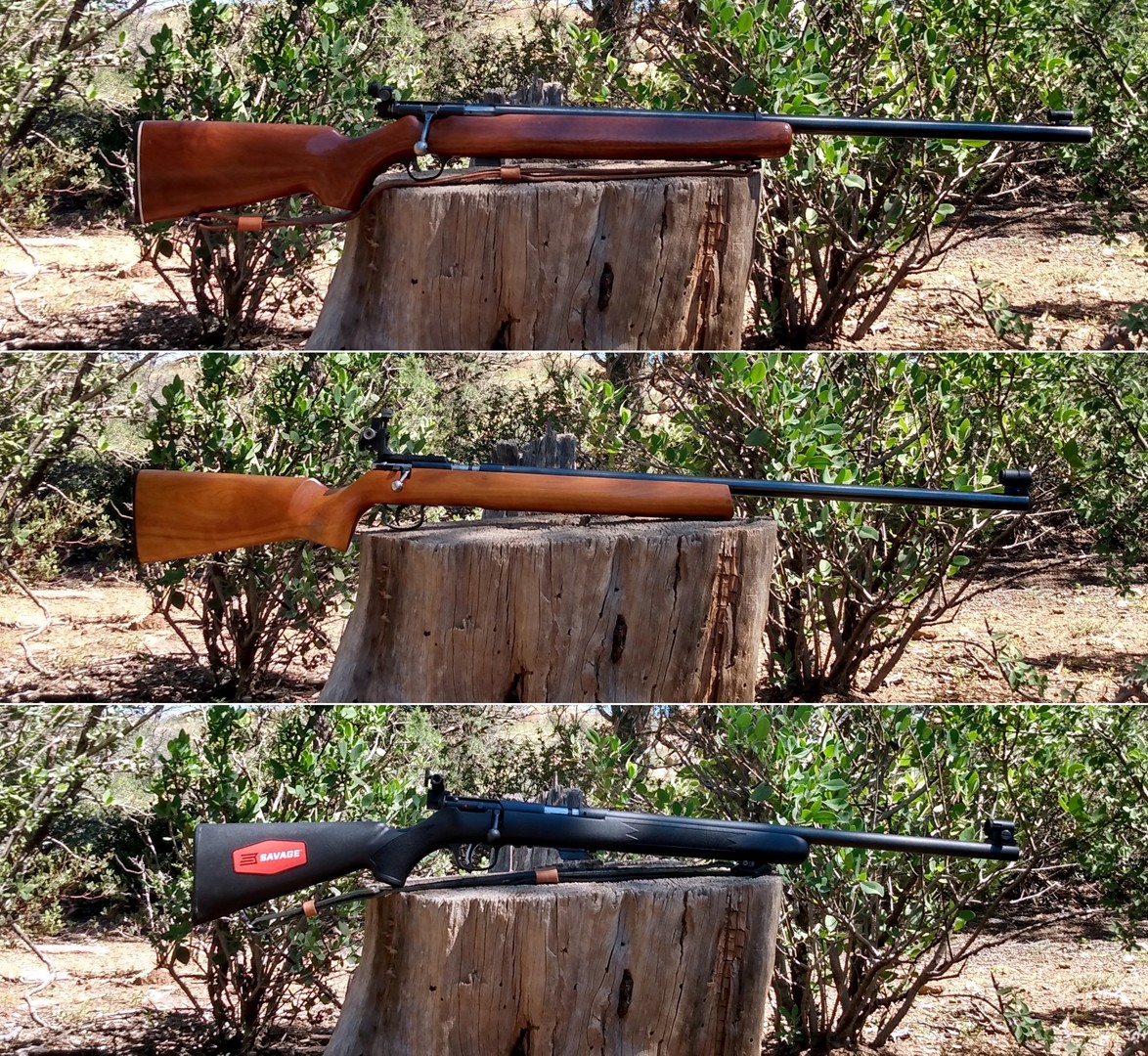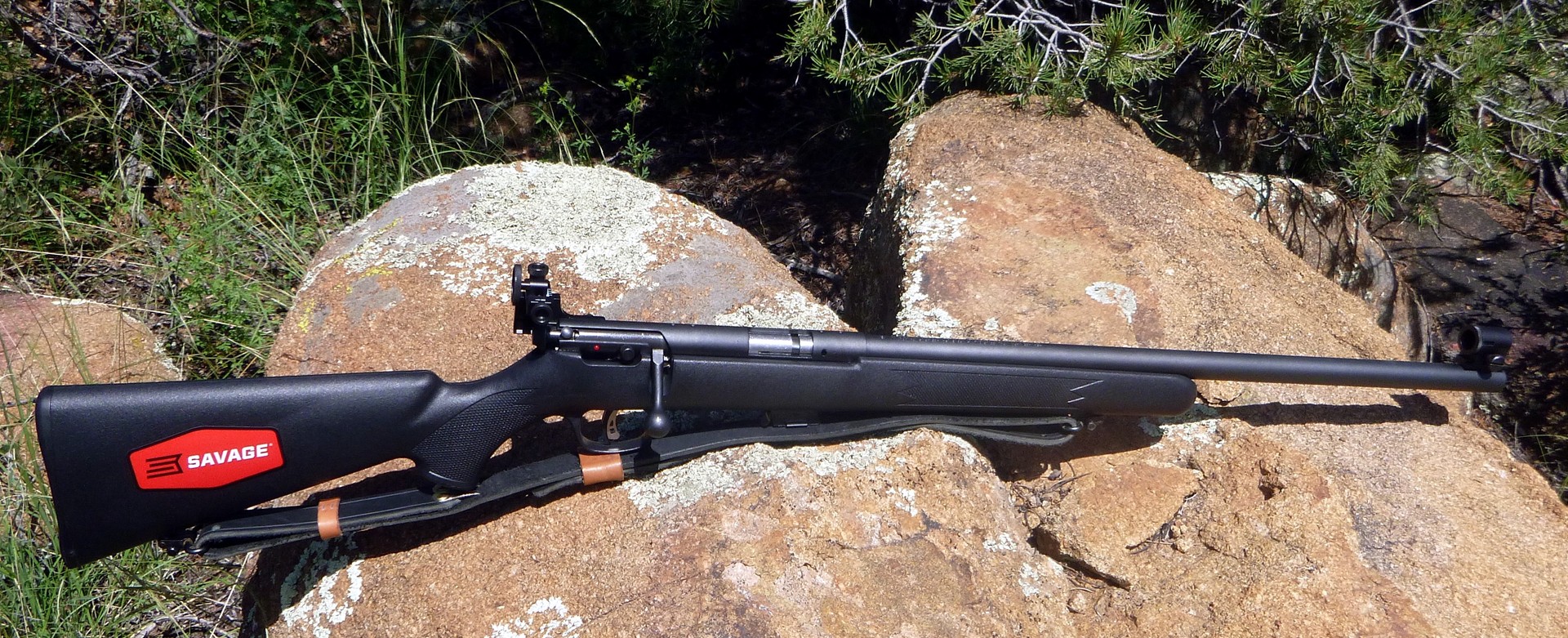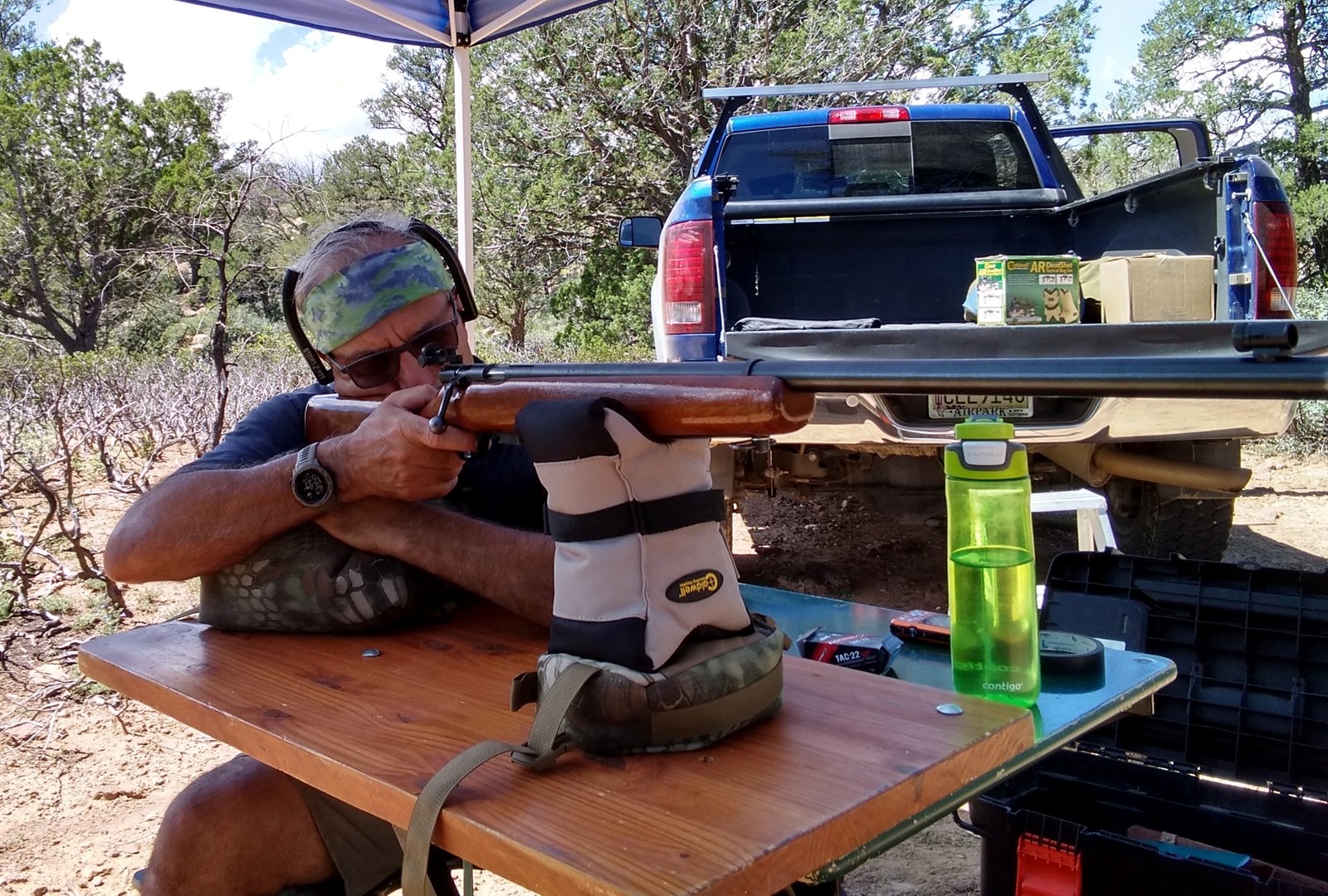Everyone contributes something. Past member John Garcia introduced us to
the BR-50 match, or as we call it today, the Precision Rimfire Benchrest
Match.
Mossberg 144 LSB
I found a big, heavy-barrel Mossberg target rifle on the used rack in a
Prescott Valley gun store, and it looked like it would be just the tool I
would need to successfully compete in the BR-50 match. Only it wasn’t.
I took off the peep sights and added a Weaver 4-16x44mm target scope on it,
only to find that frustrating flyers happened too often on those teensy little
bullseyes that comprise the BR-50 target. OK yes, it could have been the less
than top-shelf ammo I was using, but I just wasn’t having any fun in this game.
It really came to a head when my brother came out for a visit, not really a
shooter-guy. I lent him my Savage-Anschutz lightweight sporter, and he beat
me in this match when I was shooting the heavy-barrel Mossberg! With that,
the Mossberg lost its job as a BR-50 gun and I permanently lost interest in
the BR-50 match.
But somewhere around that time another past member, Mario Stajner (everyone
contributes something) suggested a .22 Iron Sight Rifle Silhouette match using
the larger pistol silhouette critters. Up to that time, we had only shot .22
rifle silhouette with scoped rifles against the tiny little critters. The
Mossberg now got a new job. Off came the scope, and back-on went the peep
sights that it came with. In this configuration, for the .22 Iron Sight Rifle
Silhouette match, the Mossberg was indeed competitive. This has now become one
of my favorite club events.
From what I can learn, the Mossberg model 144 LSB was made from the mid to late
1960’s to 1985. Interestingly, mine has a crudely electro-penciled inscription
on the receiver that says, “WEST HS PA”. I believe this means that the rifle
saw service on a high school rifle team in Pennsylvania.
The 144LSB is a descendant of the well-known Mossberg model 44US WW2 government
training rifle. Don’t ask me to trace the lineage and the changes from the 44US
to the 144LSB. Let it suffice to say, that there were a number of intermediate
models between the two.
The rear sight on the 144LSB is a Mossberg model S331, which is original to the
rifle. The front sight is a Lyman model 17A, also original. The rear sight
features an adjustable aperture, which is not original. The sights sit fairly
low on top of the barrel. With a high comb on the stock, I’ve always had to mash
my cheek uncomfortably hard against the stock to see through the peeps.
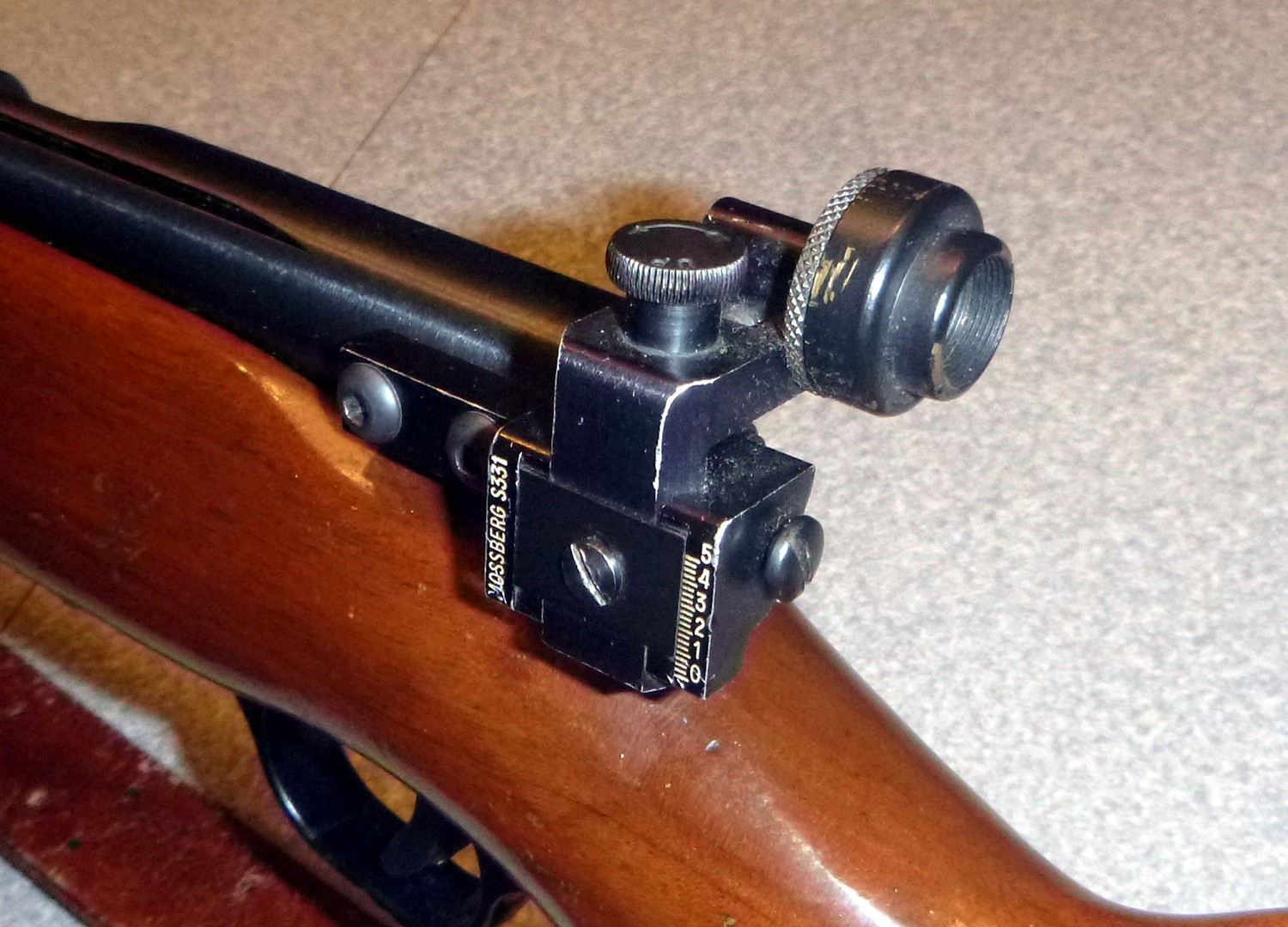
Mossberg S331 rear sight with adjustable iris aperture
|
The stock is a nice piece of walnut. With the long heavy barrel and the chunky
stock, the weight of the rifle comes in at almost 9 pounds. That does make it a
bit of a challenge over the course of a long match, to hold on-target in the
offhand standing position. I guess that they must have made high schoolers
stronger back in the day. Or maybe not …
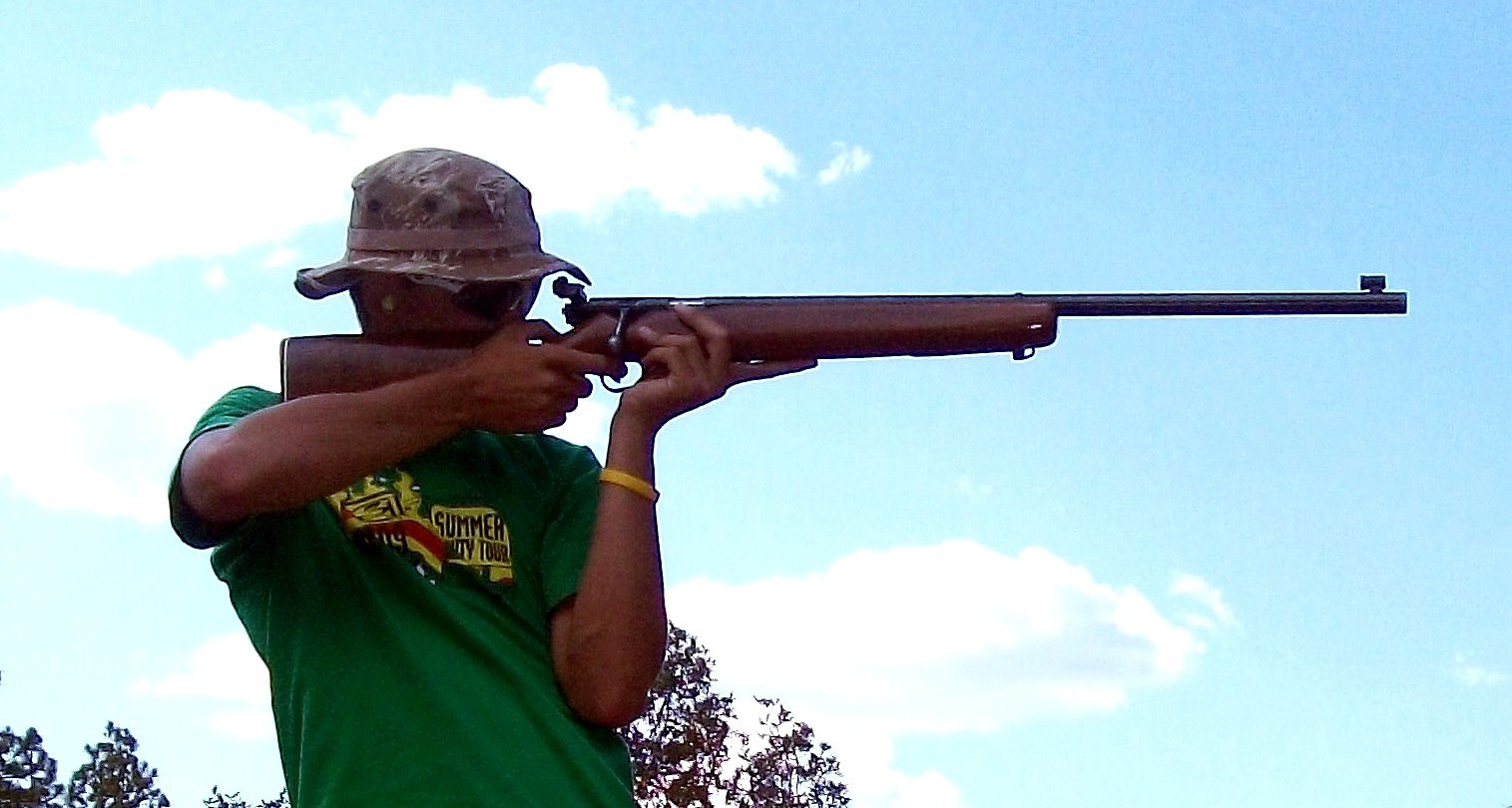
Son Sam at 15 years old shooting the Mossberg
|
Savage-Anschutz Mark 10A
Earlier in the year of the photo above, Sam and I were at the gun show perusing
the aisles. We had momentarily separated, looking at different tables. When he
next found me, he told me that he had found an interesting Anschutz target rifle
for a good price, and wanted me to go take a look at it.
Indeed it was affordable for the lad, and it was an Anschutz – a Savage-Anschutz
that is. It is marked as a model Mark 10A. We decided that it had to come home
with us – now – before someone else walked up and threw money on the table.
Prior to this, I had inherited a Savage-Anschutz sporter model 141 from my wife’s
grandfather – the one that my brother used to beat me at BR-50. I knew, and Sam
knew too, what good shooters these vintage Savage-Anschutz rifles are. If you
find one for sale, you’d better grab it!
Savage imported Anschutz rifles from the years of 1963 to 1981. Both of our rifles
are marked:
|
Savage
|
♢
|
Anschutz
|
|
Westfield, Mass. U.S.A.
|
Ulm, West Germany
|
As a matter of fact, our two rifles share the same action, known as the model 64
action. This is a less expensive action than Anschutz’s match rifles which use
the Model 54 action. Sam was having some kind of a problem with his bolt, and I
was having a different problem with my bolt. We tried swapping bolts between the
two rifles, and lo and behold, both problems were cured! So that’s how our two
rifles sit to this day.
The Mark 10A was sold primarily as an entry-level junior target rifle, so it was
not in the same premium league as the mainline Anschutz competition rifles. That’s
what makes it relatively affordable for an Anschutz. It is a single shot, so each
round needs to be manually fed into the chamber. There is a groove in the solid
bottom raceway in the action when the bolt is withdrawn, where you can simply drop
the round before pushing the bolt forward.
When we brought the Mark 10A home, the stock was in a dry and unfinished condition.
The wood appears to be European birch (not beech). One of the first things that Sam
did was to apply some Watco natural color oil finish, then top that with a coat of
spray polyurethane. Looks good now!
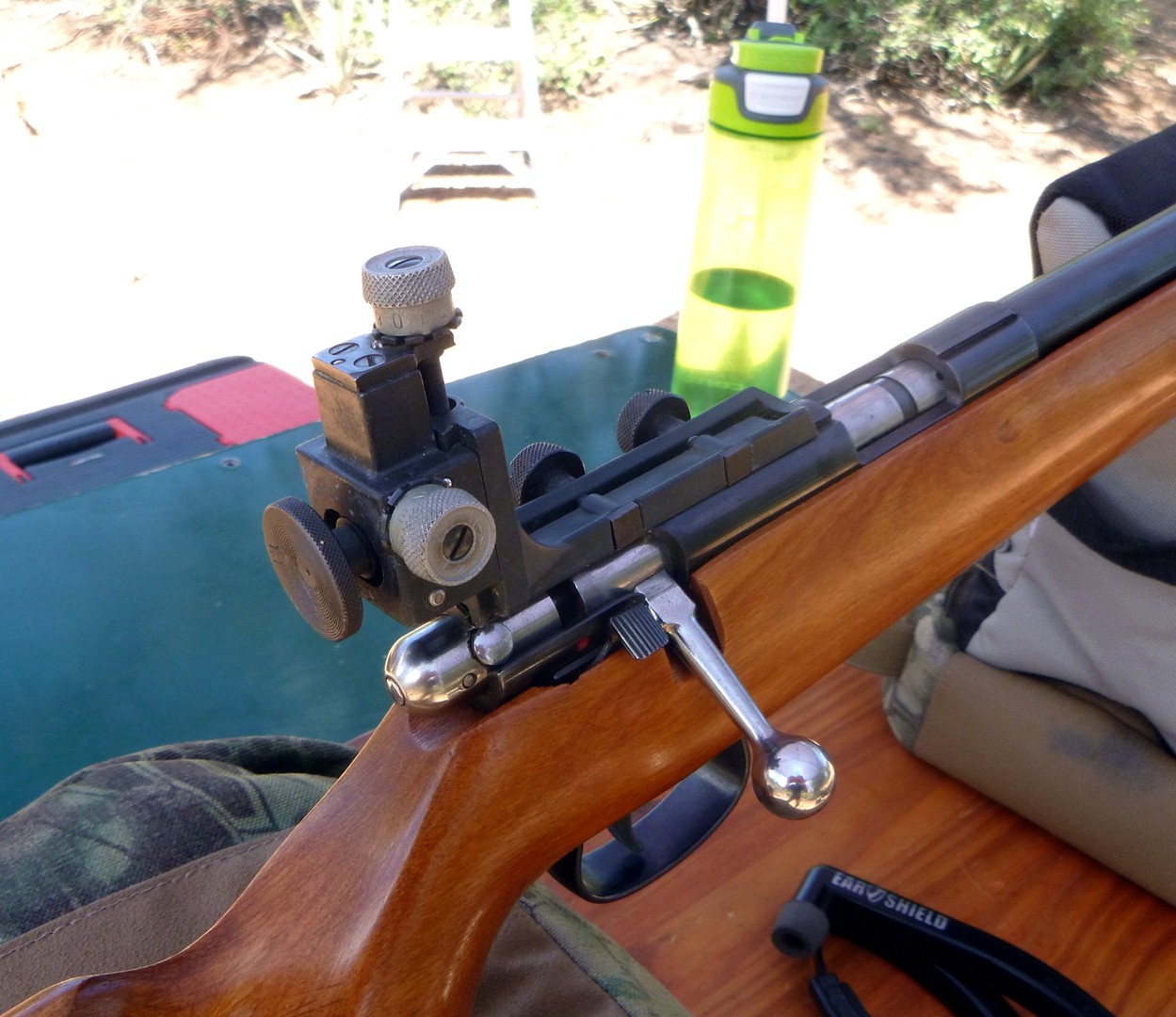
Fancy Anschutz diopter rear sight on the Mark 10A
|
The rear sight is an amazing looking contraption. The body is L-shaped. It clamps
to the .22 dovetail slots on the top of the receiver.
At the moment, I am the rifle’s caretaker. I recently changed the front sight insert
from a vertical post to a circle, so I had to re-zero the rifle. The windage knob is
marked:
← L – bei – R →
I don’t know what “bei” means, but the adjustments work backwards from how you think
they should work. While shooting the rifle for groups, I saw that I was hitting to
the right of center. So naturally, I adjusted the knob toward “L”, trying to move
the group left. Once I figured out that the groups were moving further right, I
started twisting the knob toward “R” which paradoxically moved the groups left. I
soon had the groups hitting center for windage.
The elevation knob is marked:
← T – bei – H →
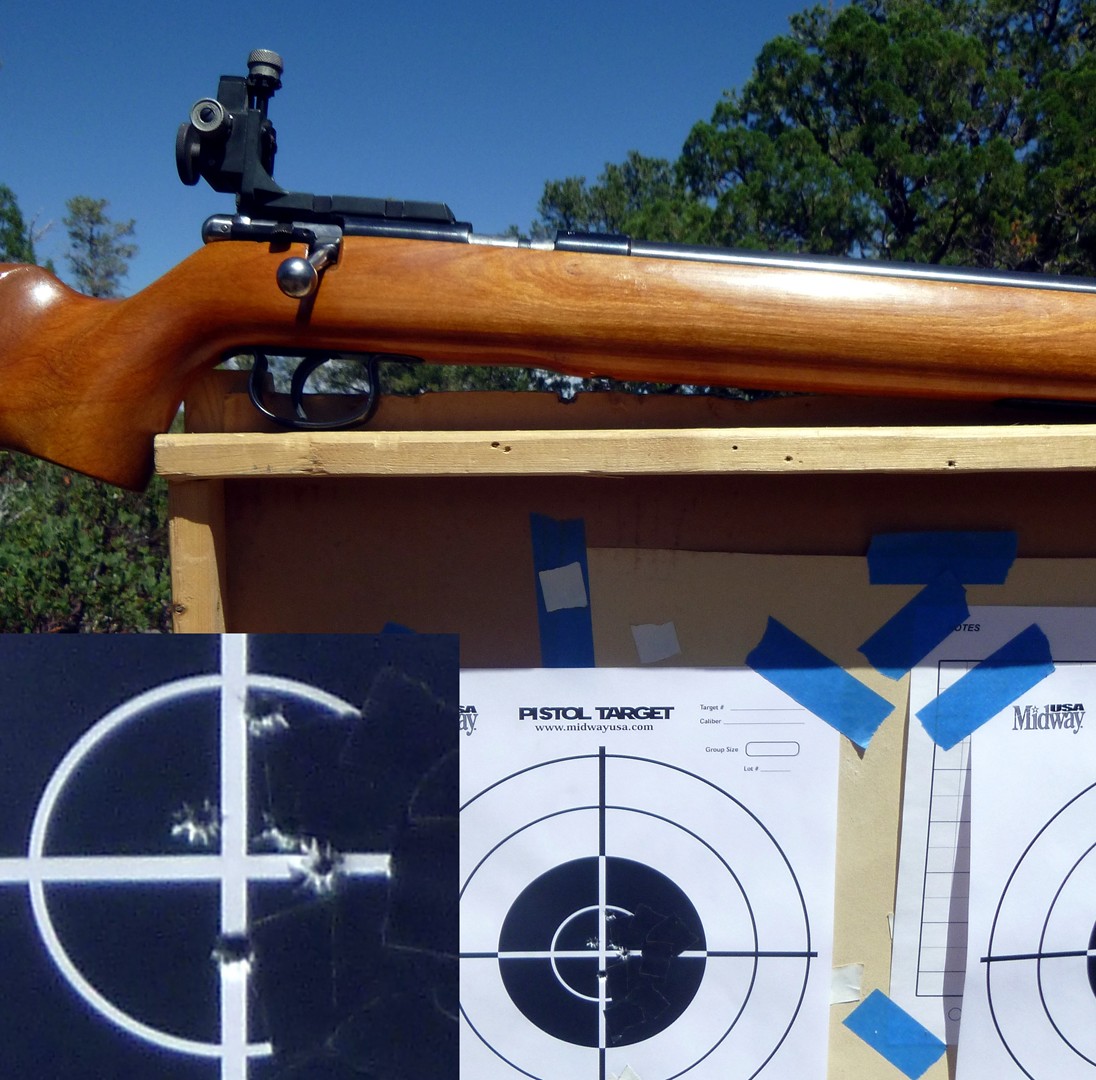
Centered. Not the best group of the day, but
representative at 1.11” at 55 yards (50 meters)
|
Since I had no idea what any of that meant, I just ignored the knob markings and
instead referenced the graduated vertical scale on the left side of the sight to
determine whether I was moving the sight up or down as I intended. Eventually, I
got the group hitting center.
Savage Mark II FVT
When the first Combo Silhouette Shoot came up in June, I asked my older son Ben,
if he was going to shoot the match. He declined, saying that he didn’t have the
right guns. I sent him a web link for the Savage Mark II FVT to point out that
he could get a new .22 target rifle with peep sights for a pretty reasonable cost.
His brother had a .22 target rifle, but Ben didn’t. (I didn’t realize at the
time that Sam’s Anschutz was still in the house, available as a loaner.)
Ben didn’t bite to buy one, but after about two weeks of thinking about it, I
decided that I should go ahead and buy one. I’ve been interested in this rifle
for a while.
The Mark II FVT appears to be the only entry-level .22 rifle equipped with
target-style peep sights available today. CMP sells this rifle at a discount,
not to individuals, but to affiliated clubs that have a youth shooting program.
We are not CMP-affiliated, and do not have a junior shooting program, so I bought
mine on the open market. No biggie, they are affordable. I spent about $450.
The Savage Mark II is a rifle made in Canada by the former Lakefield Arms. Savage
purchased Lakefield Arms in 1995. The facility was then renamed Savage Arms Canada.
The extensive lineup of rimfire rifles that Savage makes in this Canadian plant is
dazzling. But you just don’t hear much buzz about the Savage rimfires. They have
a reputation of being inexpensive, but accurate shooters.
The Mark II FVT is a variation of the Mark II FV. If you know Savage model code
nomenclature, then you know that F means synthetic stock, and the V means heavy-barrel,
as in Varminter. The T added to the nomenclature designates target sights. These
sights are made by the Williams sight company. The FV is not equipped with any sights,
but it does comes with Weaver-type scope bases installed.
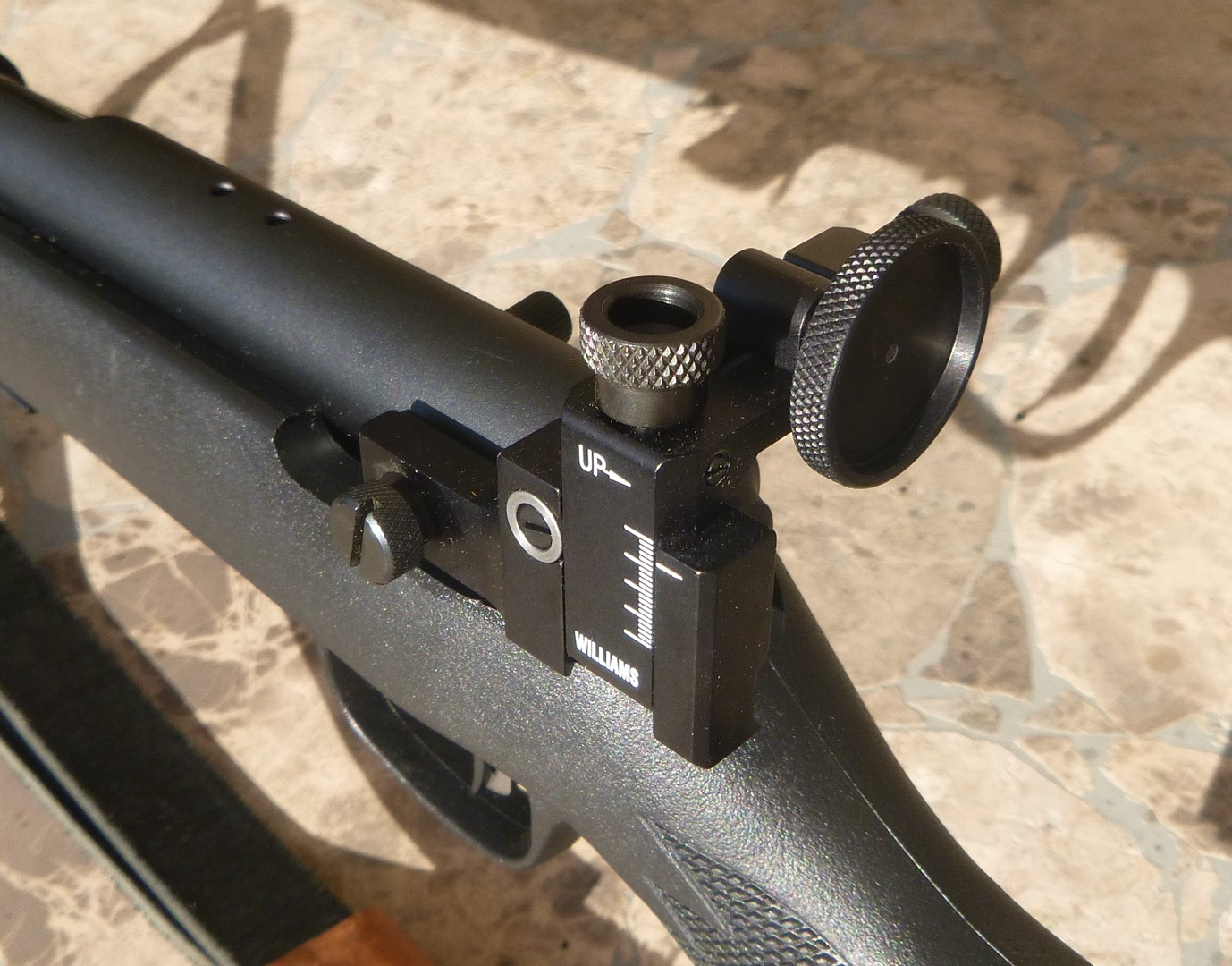
Williams FP receiver sight on the Savage Mark II FVT |
The MSRP of the FV is only $279, but for the FVT it’s a whopping $529! So it costs
$250 (at MSRP) to get the Williams peep sights, almost doubling the cost of the rifle.
Theoretically, one could buy the FV, and his own set of Williams sights and DIY.
Or you could pay the factory to do it for you professionally, as I did. It’s not
just the added cost of the front and rear sights, but also drilling and tapping the
side of the receiver for the sight mount, relieving the top corner of the stock
to make room for the sight, and dovetailing the front of the barrel to mount the
front sight.
The stock is inexpensive molded plastic. Critics of the stock call it “milk jug
plastic”. It really is pretty soft. When I unpacked the rifle from the box, I
checked the security of all the screws. I blue Loctited the receiver sight mount to
make sure it would not wiggle loose during a match. I tightened the stock screws as
well. As I did so, I noticed that the forend of the stock started moving down away
from the barrel, opening up a gap. I took this as a good thing that the stock would
not be interfering with barrel harmonics!
Another thing you will notice about the shape of the stock compared to the two
wood-stocked rifles in this story, is that the Mark II stock has a great deal of drop
at the comb, where the two wood stocks come back pretty straight without much drop at
all. To me, this was a positive feature, not a bug. I mentioned earlier how I have
to mash my cheek down really hard on the Mossberg’s stock to be able to see through
the peeps. That is not a problem for me with the FVT.
The plastic stock and the shorter barrel also means that the FVT is considerably
lighter than the Mossberg. The FVT weighs 6.3 pounds compared to the Mossberg’s 8.8
pounds (with slings on both). As for barrel length, the FVT’s is 21”, whereas the
Mossberg’s barrel is a shade over 27”. All three barrels are straight, not tapered
in contour. The Savage Mark II FVT appears to me to be the best target rifle of the
three for junior shooters.
The FVT also boasts Savage’s bladed AccuTrigger. I measured the pull weight at a
very nice 1lb. 9 ounces (average of 5 pulls). The pull weight is also supposed to
be easily adjustable, but I’m just going to leave it as is.
Shooting the Three, Side-by-Side
I recently decided to get out of the Valley, into cooler, higher country to test the
rifles side-by-side. But it was still pretty warm. The temperatures were in the
high 80’s.
I set up a target at 55 yards – the exact distance to the pig silhouettes. I zero at
this distance and just adjust my hold for the other three critters on the pistol
silhouette range.
The ammo I used was Norma TAC-22. This is “target-grade” ammo, but not “match-grade”.
I used a Midway pistol
target which features a round black bull 4 inches in diameter. With the rear peep,
and a circle front sight insert, you align a series of concentric circles to achieve a
perfect sight picture. I recorded the first 3 groups fired with each rifle. I
actually shot more than that as I worked to perfect the zero on each of the three
rifles. The results are shown below, along with some other pertinent measurements that
I made for all three guns.
I shot the FVT for the first time in competition at the last Combo Silhouette Match.
I surprised myself by improving on my personal best with a score of 31. Actually, I
also hit three rams that pinged, but didn’t drop. I forgot to pack along my Aguila
Interceptor ammo that might have allowed me a couple more knockdowns.
I wasn’t the only one shooting a peep-sighted bolt rifle that day. Wade used a
Remington Model 513T Matchmaster, and Bill Foster used a Marlin Glenfield that I
didn’t catch the model number of.
Looking back at our club results for the last couple of years, the highest score I
saw in a .22 Iron Sight Rifle stage was 33. We shoot two Combo Silhouette Matches,
and of course, a dedicated Iron Sight match each year. For this year, we’ve now
added a .22 Combo Match in December. If you don’t have one, you might consider
adding a peep-sighted .22 target rifle to your collection, classic or new.
 Summary comparison of three peep-sighted .22 LR target rifles. Average of 3 groups fired at 55 yards (50 meters).
Summary comparison of three peep-sighted .22 LR target rifles. Average of 3 groups fired at 55 yards (50 meters). |


